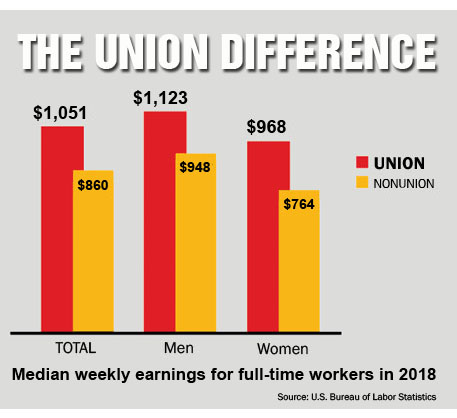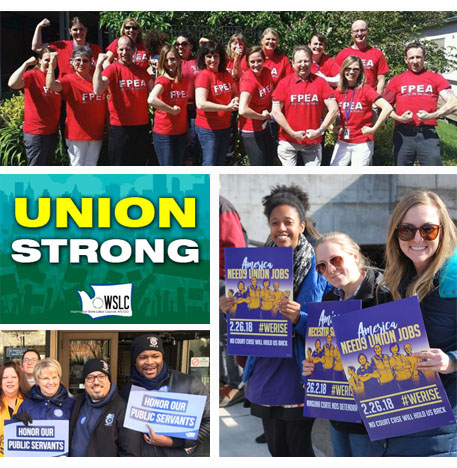TAKE A STAND!
Unions in Washington state post big membership gains
With 649,000 members in 2018, Washington is 3rd most unionized in U.S.
SEATTLE (Jan. 18, 2019) — More and more people in Washington state are seeing the value of joining together in unions.
The state’s union membership rate increased to 19.8 percent of the total workforce in 2018, up from 18.8 percent in 2017, according to a report released today by the U.S. Department of Labor’s Bureau of Labor Statistics. With an additional 65,000 workers joining the ranks last year, there are now an estimated 649,000 union members in Washington, making it the third most unionized state in the nation.
 “This is great news for all of Washington’s working families,” said Larry Brown, President of the Washington State Labor Council, AFL-CIO. “Union members earn more money, they boost our state and local economies, and they lift working standards for everyone. These numbers show that, despite outdated and hostile labor laws that create obstacles to unionization, working people here in Washington continue to buck national trends and join together to negotiate a fair return for their work.”
“This is great news for all of Washington’s working families,” said Larry Brown, President of the Washington State Labor Council, AFL-CIO. “Union members earn more money, they boost our state and local economies, and they lift working standards for everyone. These numbers show that, despite outdated and hostile labor laws that create obstacles to unionization, working people here in Washington continue to buck national trends and join together to negotiate a fair return for their work.”
Union members earn higher wages, with median weekly earnings of $1,051 compared to $860 for nonunion, according to the new BLS report. With union wages averaging more than 22 percent higher than nonunion wages, full-time union members make more than $54,600 per year on average, which is about $10,000 more than nonunion workers.
 JOIN TOGETHER! — If you don’t have a union at your job, learn how to join together with your co-workers and negotiate a fair return for your work. Click here to get started.
JOIN TOGETHER! — If you don’t have a union at your job, learn how to join together with your co-workers and negotiate a fair return for your work. Click here to get started.
National union membership levels, which have dropped in recent years as Republican lawmakers and conservative court decisions have actively discouraged unionization, dropped slightly from 10.7 percent to 10.5 percent in 2018, according to the BLS.
With its 19.8 percent union membership rate, Washington is the third most unionized state in the nation. Only Hawaii (23.1) and New York (22.3) have a higher percentage of their workforce unionized. The comparatively low national union membership rate of 10.5 percent is driven down by so-called “right-to-work” states like South Carolina (2.7), North Carolina (2.7), Virginia (4.3), and Texas (4.3) that actively discourage unionization.
Right-to-work laws ban unions and employers from agreeing to union-security clauses that require everyone who benefits from the contract to pay a fair-share representation fee. These laws, which have racist origins, require unions to represent everyone, regardless of whether they pay any dues or representation fees. (It’s like allowing people to opt out of paying taxes but still receive all government services.) Right-to-work laws weaken unions financially, make it much harder to organize workplaces and negotiate contracts, and result in those states having lower wages.
In 2018, the U.S. Supreme Court ruled 5-4 along ideological lines on Janus v. AFSCME to impose right-to-work restrictions on public employee unions nationwide, including in Washington. That means all unions representing state and local government employees are banned from having fair-share provisions in their contracts to ensure all pay their fair share. (Learn more about the Janus decision and how/why it happened here.)
 Brown said that unions in Washington have been preparing for such a decision for years and have actively engaged their memberships to stress the importance of staying “Union Strong” and retaining their full union membership.
Brown said that unions in Washington have been preparing for such a decision for years and have actively engaged their memberships to stress the importance of staying “Union Strong” and retaining their full union membership.
“Public employee unions in Washington have re-engaged their members like never before and I think our growing membership rate shows that continuing effort has been successful,” he said. “The people who keep our communities safe, care for the elderly and disabled, teach and protect our children, maintain our roads, and provide other essential services in Washington understand the value of their unions. If anything, Janus has energized them to fight even harder for strong unions, quality public services, and a fair return on their work.”
In addition to earning higher wages, another federal report showed that union members are far more likely to have employer-provided retirement and health care benefits than their nonunion counterparts. The Bureau of Labor Statistics found:
— 95 percent of union workers had the option of an employer-sponsored health care plan, compared to 69 percent of nonunion workers;
— 94 percent of union workers had the option of an employer-sponsored retirement plan, compared to 65 percent of nonunion workers; and
— 93 percent of union workers had the option of an employee-sponsored prescription drug insurance, compared to 67 percent of nonunion workers.
In addition, the quality of the benefits provided to union workers typically was better, the data showed. For example, workers were expected to contribute 19 percent toward the cost of the family’s health care under union-negotiated benefits plans, while nonunion workers were forced to shell out 35 percent of the cost, which represents an 84 percent increase in out-of-pocket costs.





